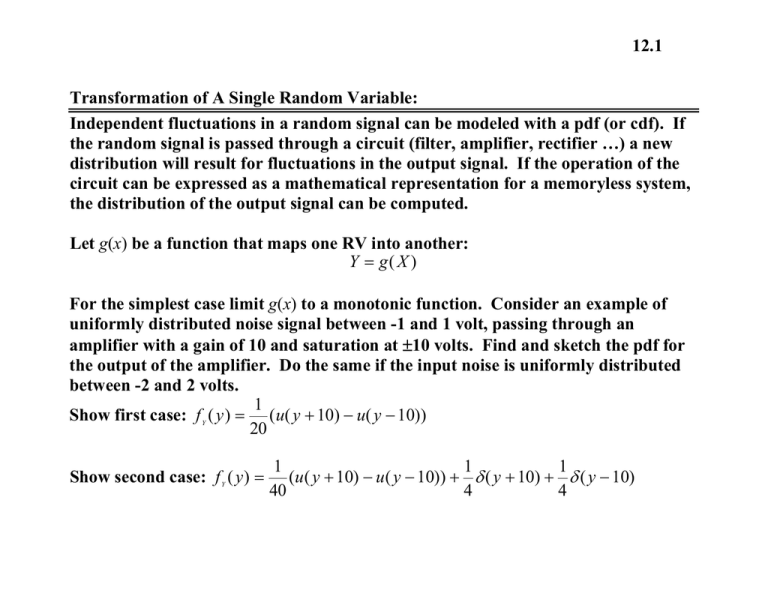12.1 Transformation of A Single Random Variable:
advertisement

12.1 Transformation of A Single Random Variable: Independent fluctuations in a random signal can be modeled with a pdf (or cdf). If the random signal is passed through a circuit (filter, amplifier, rectifier …) a new distribution will result for fluctuations in the output signal. If the operation of the circuit can be expressed as a mathematical representation for a memoryless system, the distribution of the output signal can be computed. Let g(x) be a function that maps one RV into another: Y = g( X ) For the simplest case limit g(x) to a monotonic function. Consider an example of uniformly distributed noise signal between -1 and 1 volt, passing through an amplifier with a gain of 10 and saturation at ±10 volts. Find and sketch the pdf for the output of the amplifier. Do the same if the input noise is uniformly distributed between -2 and 2 volts. 1 Show first case: f ( y ) = (u( y + 10) − u( y − 10)) 20 Y Show second case: f ( y ) = Y 1 1 1 (u( y + 10) − u( y − 10)) + δ ( y + 10) + δ ( y − 10) 4 4 40 12.2 To obtain a process for a general transformation between continuous RVs let y = g ( x ) where g(x0) is a monotonically increasing function, then: F ( y ) = P(Y ≤ y ) = P[ g ( X ) ≤ g ( x )] = P ( X ≤ x ) = F ( x ) dx Show that f ( y ) = f ( x ) dy Likewise show if the case of a monotonically decreasing function, then: F ( y ) = P (Y ≤ y ) = P[ g ( X ) ≥ g ( x )] = 1 − P( X ≤ x ) = 1 − F ( x ) dx dx For either increasing or decreasing f ( y ) = f ( x ) Show f ( y ) = − f ( x ) dy dy Examples: A zero mean Gaussian noise signal with an average power of .01 watts is passed through a linear amplifier circuit with a gain of 40 dB. Find the pdf of the noise at the output. What would the pdf be if the amp also added a bias of .5 volts? 1 ⎛ y ⎞ exp⎜ − Case 1 f ( y ) = ⎟ where σ = 10 ⎝ 2σ ⎠ 2π σ 0 Y 0 0 0 0 Y 0 X 0 X x = g −1 ( y ) Y 0 0 Y 0 0 X X 0 Y x = g −1 ( y ) x = g −1 ( y ) 2 Y 2 2 ⎛ ( y − m) ⎞ exp⎜ − Case 2 f ( y ) = ⎟ 2π σ 2σ ⎠ ⎝ 2 1 Y 2 X 2 where σ = 10 and m = 0.5 12.3 If Y=g(X) is not monotonic, then X=g-1(Y) will not be a function. Consider Y =|X| x=ginv(y) 10 9 8 8 6 7 4 6 2 5 0 x y y=g(x) 10 4 -2 3 -4 2 -6 1 -8 0 -10 -8 -6 -4 -2 0 x 2 4 6 8 10 -10 0 1 2 3 4 5 y 6 7 8 9 10 dx does not exist. However, for the dy purpose for mapping one RV to another, this means that ±X is mapped into the same Y. Therefore, nonmonotonic functions should be parsed into regions over x where X=g-1(Y) exists as a function. Example: A zero mean 4 watt white Gaussian signal is passed through a recitfier. Find the distribution of the output. −y ⎞ 2 Show: f ( y ) = exp⎛⎜ ⎟ for 0 ≤ y < ∞ where σ = 2 ⎝ 2σ ⎠ 2π σ Since X=g-1(Y) is not a function, the derivative 2 Y 2 2 12.4 In general, if a function is applied to a single RV Y=g(X) the distribution of a transformed RV is computed via: dx f ( y) = ∑ f ( x) where x = g ( y ), i = 1,2,3,... N is a parsing of the function dy into monotonic regions. Example: An exponentially distributed RV f ( x ) = 2 exp( −2 x )u( x ) is transformed by the function Y=(X-4)2. Find the pdf of Y. ⎧ ⎛ exp(2 y ) + exp( −2 y ) ⎞ exp( − 8 ) for 0 ≤ y < 16 ⎜ ⎟ ⎪ y ⎝ ⎠ ⎪ Show: f ( y ) = ⎨ ⎪exp( −8)⎛⎜ exp( −2 y ) ⎞⎟ for 16 ≤ y < ∞ ⎪⎩ y ⎝ ⎠ N −1 i Y i =1 X i i xi = gi−1 ( y ) X Y pdf of Y pdf of X 0.25 2 1.8 0.2 1.6 1.4 0.15 1.2 1 0.1 0.8 0.6 0.05 0.4 0.2 0 0 0 5 10 15 X 20 25 30 0 5 10 15 Y 20 25 30




